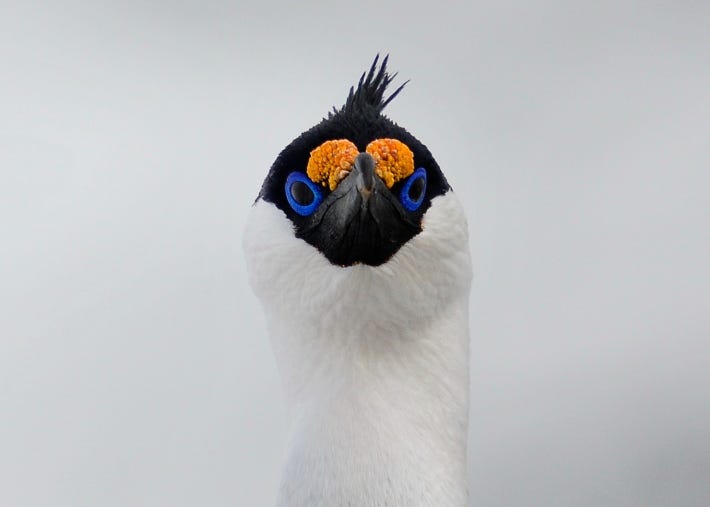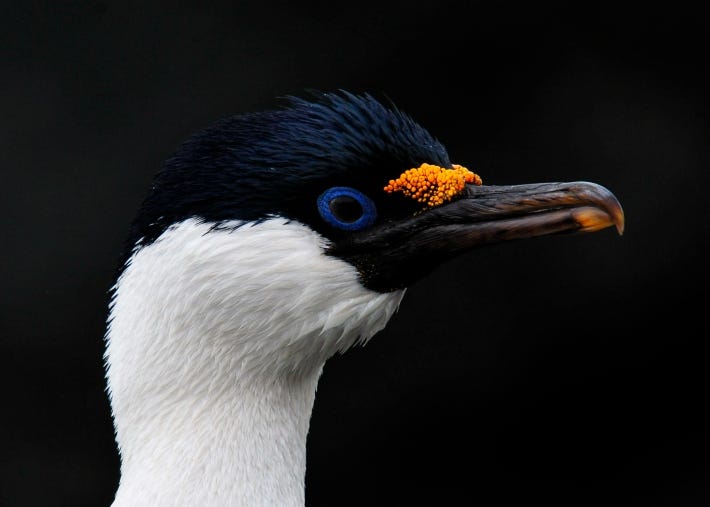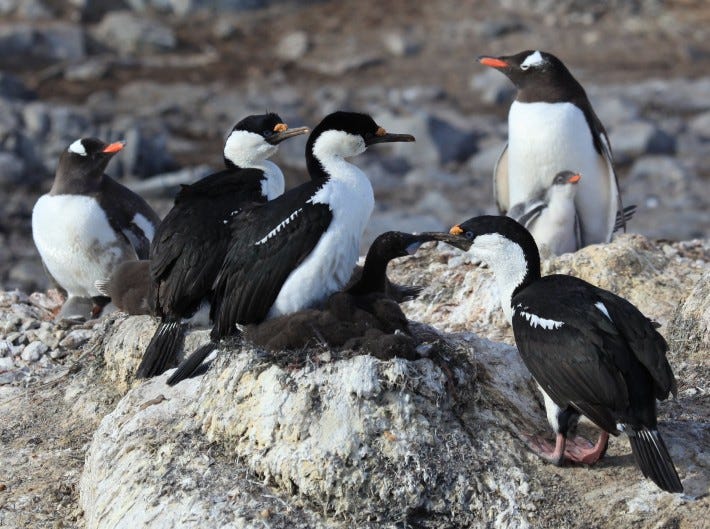
This week's Bird of the Week is...the antarctic shag. It's shagadelic!!! (I PROMISE that is the only time I will make this joke, but come on now.)
There is so much I could say about the antarctic shag, but I have to start with the face.

Unforgettable things going on here. The ring of blue around the eyes, the haughty beak-work, and of course all that orange stuff. Caitlin compared it to pollen, but Wikipedia tells me it is known as a "caruncle," which is a fleshy bit of flesh that some birds have. (The things on turkeys? Yeah, caruncle time.) This all adds up to a highly worthy bird.
The second thing to discuss is the name "antarctic shag." It's a great name, but it is only one of approximately 700 million names for this bird, as the site Wildfoot reminds us:
The Antarctic Shag is also known as the Imperial Cormorant, the King Cormorant, the Imperial Shag, the Blue-eyed Shag or the Antarctic Cormorant. There is often confusion around the names cormorant and shag, but they are simply different names for the same bird. Some consider all of the above to be sub-species of a single species of cormorant, while others view them all as a single species – the jury is still out!
That's six different names, and this bird sparks mega-debate among bird people about its bird status? Iconic. There are even multiple Latin names for our buddy Shaggy. Phalacrocorax atriceps? Leucocarbo bransfieldensis? Take your dang pick! Speaking of picks, here's another, erm, pick-ture:

Some things to know about the antarctic shag: it is found in Antarctica, along with some other very southern and cold islands near Antarctica; several websites stress that it's into monogamy; it likes to hang out in relatively small groups of a few hundred; and it enjoys eating fish, worms, and other crustaceans.
Here are some other "shag facts" from the website Oceanwide Expeditions:
—Blue-eyed Shags are the only kind of cormorant to enter the Antarctic proper.
—The Blue-eyed Shag (depending on an individual’s location in the world) is the only Antarctic bird that will maintain a nest year-round if the area is always free of ice.
—Blue-eyed Shags don’t travel far from their nests to feed. This made them a welcome sight for sailors and explorers at sea who, when spotting one of the birds, would know that land was nearby.
—Blue-eyed Shags are the only Antarctic birds whose chicks are born without a protective down leaving them especially dependant on their parents to keep them warm for the first few weeks of their lives.
—Blue-eyed Shags are constantly on the prowl to try to steal nesting material from their neighbours.
LOL at that last one. Birds are so shady! Whoa, we haven't had a picture in a while. One of the cool things about the shag is that it also "chills" with penguins. See for yourself:


Penguin's just there, looming. (These are Gentoo penguins specifically.)

In conclusion: shagadelic!!! (Sorry, I lied when I said I was only going to do that joke once.)
A reminder: you can check out our complete Bird of the Week list here, and get in touch with your bird suggestions at hello@discourseblog.com.











